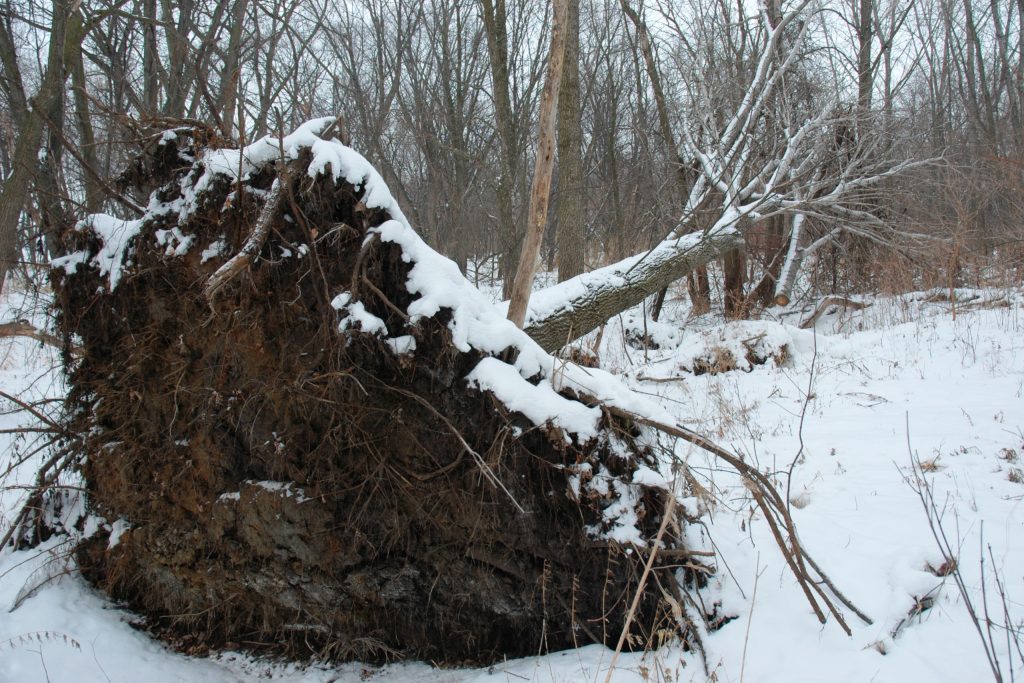Winter weather can be hard on trees, and the damage often goes unnoticed until it’s too late. Freezing temperatures, heavy snow, and strong winds all contribute to the strain on your trees, but if caught early, the effects can be minimized.
Here’s how to spot common winter tree damage and the steps you can take to address it:
Common Types of Winter Tree Damage
Frost Cracks
Frost cracks typically appear as vertical splits along the trunk of a tree, especially when temperatures fluctuate dramatically between day and night. As the tree expands and contracts with the temperature changes, the outer bark can crack. While frost cracks might heal over time, if left unmonitored, they can become entry points for pests and pathogens, weakening the tree’s structural integrity.
Broken and Weakened Branches
Snow and ice accumulation are often the culprits when branches break. Even healthy, well-established trees can have limbs snap under the weight of heavy snow or ice. Unfortunately, broken branches are more than just an eyesore—they can pose serious safety hazards to people and property below.
Sunscald
While it may seem counterintuitive, cold-weather damage like sunscald can occur on sunny winter days. When a tree’s bark warms up during the day and then freezes again at night, this constant temperature fluctuation can damage the cambium layer, leading to discolored or peeling bark. Young trees and those with thin bark are particularly at risk.
Root Damage
The freeze-thaw cycle can also affect a tree’s roots. Constantly frozen ground followed by periods of thawing can disrupt the roots’ ability to absorb water and nutrients, especially if snow or ice compacts the soil. Damaged or stressed roots may have trouble supporting healthy growth when the weather warms.
How to Spot Damage Early
Winter tree damage can be subtle at first, but being proactive in your inspection can help you catch potential issues before they worsen.
- Bark Inspection: Look for cracks, discoloration, or any peeling of the bark, which could indicate frost cracks or sunscald.
- Branch Inspection: Check for broken or hanging branches that may have been weakened by snow and ice. These are not only unsafe but can also make the tree more prone to disease.
- Canopy Shape: While trees are dormant during the winter, the overall shape of the canopy can still give you clues about its health. Look for any limbs that appear to be leaning, broken, or otherwise misshapen.
- Root Zone: If the snow around your tree’s base has melted, check for any exposed roots, soil erosion, or signs of upheaval, which could indicate root damage.
Steps to Address Winter Tree Damage
Once you’ve identified signs of winter damage, it’s important to address them promptly to prevent further harm. Here’s how:
- Prune Broken or Damaged Branches
Broken branches not only weaken a tree’s structure but can also invite pests and disease. Carefully prune these limbs to encourage healthy regrowth. For larger or hard-to-reach branches, it’s best to hire a professional arborist who has the expertise and tools to handle the job safely. - Treat Frost Cracks
Frost cracks often heal naturally over time, but they should be monitored for signs of decay or pest infestations. Avoid applying paint or sealants to the cracks, as these can trap moisture and worsen the problem. - Prevent Sunscald
Young trees or those with thin bark are especially vulnerable to sunscald. Wrapping their trunks with burlap or tree guards during the winter can provide a protective barrier. Be sure to remove the wrapping in early spring to avoid moisture buildup. - Clear Snow and Ice Safely
Snow accumulation can be gently removed from branches with an upward sweeping motion using a broom. Never attempt to chip away ice, as this can cause additional damage to the tree. - Schedule a Professional Inspection
An ISA certified arborist can assess the extent of the damage and recommend tailored solutions to restore your tree’s health. Professional expertise ensures that potential risks are identified and addressed safely.
Looking Ahead: Spring Health Starts Now
While it may feel like winter is far from over, addressing tree damage now sets the stage for a healthier spring season. Trees that are free from broken branches, frost cracks, and other issues will be better equipped to thrive as temperatures rise. By taking the time to inspect and address any winter damage, you’re giving your trees the best chance for strong growth and resilience when warmer weather arrives.
Don’t Wait—Contact the Experts Today
At Clean Cut Tree & Landscape, we understand the challenges winter can bring for trees. That’s why we’re here to help you spot and address damage early, so your trees can flourish all year long. Whether it’s pruning, root inspection, or advice on preventing future damage, our team is ready to assist you.
Reach out today for a consultation or inspection. Your trees will thank you when spring arrives.

